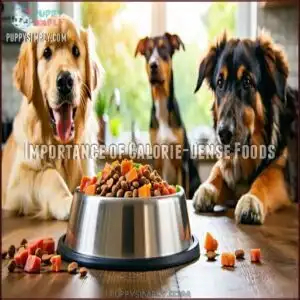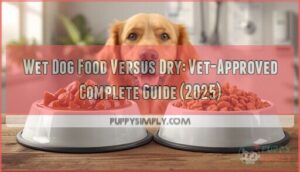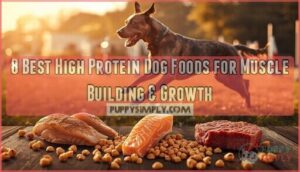This site is supported by our readers. We may earn a commission, at no cost to you, if you purchase through links.
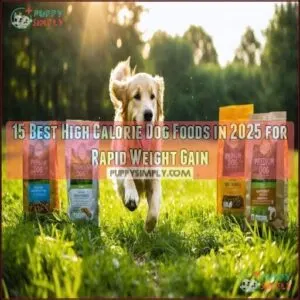 If your pup’s looking a bit skinny, high calorie dog food might be the game-changer you’re seeking.
If your pup’s looking a bit skinny, high calorie dog food might be the game-changer you’re seeking.
These nutrient-packed meals are designed to help underweight dogs bulk up safely and quickly. You’ll want to look for formulas rich in protein and healthy fats that provide dense calories without unnecessary fillers.
Brands like Purina Pro Plan and Bully Max offer specialized options that can help your furry friend gain muscle and maintain energy.
Remember, not all high-calorie foods are created equal – quality matters more than quantity. Consulting your vet can help you choose the perfect nutrition strategy for your dog’s specific needs.
Table Of Contents
- Key Takeaways
- Choosing High Calorie Dog Food
- Top 15 High Calorie Dog Foods
- 1. Adirondack Puppy Food Chicken Meal Brown Rice
- 2. Natures Logic Chicken Dog Food
- 3. Purina Pro Plan High Calorie Dog Food
- 4. Grain Free Chicken Dog Food
- 5. ZIWI Peak Beef Air Dried Dog Food
- 6. Earthborn Holistic Grain Free Bison Dog Food
- 7. Grain Free Beef Dog Food
- 8. Kinetic Performance Power 30K Dog Food
- 9. ORIJEN Original Grain Free Dog Food
- 10. Purina Pro Plan Sport Dog Food
- 11. Natures Logic Chicken Feast Dog Food
- 12. CRAVE Grain Free White Fish Salmon
- 13. Rachael Ray Puppy Chicken and Rice
- 14. Wellness Senior Chicken and Barley Dog Food
- 15. Bully Max High Protein Dog Food
- Dog Weight Gain Strategies
- High Calorie Dog Food Benefits
- Safe Weight Gain Tips
- Frequently Asked Questions (FAQs)
- How Can You Tell If Your Dog Is underweight?
- What is the best dog food to gain weight?
- What is the highest calorie dog food?
- What is the highest calorie dog food for weight gain?
- What food can I give my dog to gain weight?
- How long does it take to see weight gain?
- Should high-calorie food be mixed with regular food?
- What time of day is best for feeding?
- Are homemade high-calorie foods safe for dogs?
- How often should a dogs diet change?
- Conclusion
Key Takeaways
- You’ll want to focus on high-protein dog foods with 30-45% protein and 400-600 kcal per cup to help your underweight pup gain muscle and energy effectively.
- You can’t just feed more food – track your dog’s body condition, energy levels, and coat health to ensure you’re supporting healthy weight gain through strategic nutrition.
- You’ll need to choose nutrient-dense foods free from artificial additives, with whole meat ingredients that support digestion and provide essential fatty acids for overall health.
- You should consult your veterinarian throughout the weight gain process to rule out underlying health issues and get personalized guidance on the best high-calorie diet for your specific dog.
Choosing High Calorie Dog Food
If your dog’s struggling to maintain a healthy weight, choosing the right high-calorie dog food can make all the difference.
When nutrition meets compassion, every dog finds their path to health and happiness.
You’ll want to focus on nutrient-dense options that pack powerful calories, support muscle development, and meet your pup’s unique nutritional needs.
Importance of Calorie-Dense Foods
In the sphere of dog nutrition, calorie-dense foods are your pup’s ticket to ideal energy intake.
Puppies need more protein and fat for growth, while adult dogs require careful portion control to prevent obesity.
High-calorie, nutrient-dense diets support muscle development and overall health, but it’s vital to balance palatability with nutritional value to keep your furry friend thriving.
AAFCO guidelines guarantee that commercial dog foods meet minimum nutritional standards to ensure a balanced diet and support overall health.
Key Considerations for High-Calorie Diets
After understanding calorie-dense foods, it’s time to get smart about high-calorie dog diets.
When selecting high calorie dog food, focus on AAFCO requirements and balanced nutrition.
Check protein sources and fat content carefully.
Look for whole meat ingredients, healthy fats, and appropriate calorie content that matches your dog’s specific needs without overfeeding.
Benefits of Protein-Rich Calories
After exploring high-calorie diet foundations, let’s tap into protein’s power for your pup’s health.
Protein isn’t just food—it’s fuel for muscle development and vitality.
Consider these muscle-building benefits:
- Supports rapid tissue repair and recovery
- Provides sustained energy for active dogs
- Boosts immune system functionality
- Increases muscle mass without excess fat
High protein dog food transforms nutrition from mere sustenance to overall wellness.
Top 15 High Calorie Dog Foods
If your dog’s struggling to pack on pounds, you’re in the right place for high-calorie nutrition solutions.
Our exhaustive list of top 15 high-calorie dog foods will help you find the perfect meal to support your pup’s weight gain journey and overall health.
1. Adirondack Puppy Food Chicken Meal Brown Rice

Packed with 30% protein and 20% fat, Adirondack Puppy Food delivers a nutritional powerhouse for growing dogs.
Slow-cooked in small USA batches, this chicken meal and brown rice formula supports muscle development and cognitive function.
It’s free from corn, wheat, soy, and artificial additives, making it ideal for sensitive pups. With omega 3 and 6 fatty acids, this kibble promotes healthy skin and coat.
Perfect for puppies and performance dogs, it’s a family-crafted solution that’ll have your furry friend thriving.
Notably, puppies need to meet AAFCO requirements for complete nutrition.
Best For: Puppies and performance dogs needing high-protein, nutrient-dense food for muscle development, energy, and sensitive digestion.
- High 30% protein and 20% fat content supports growth and energy.
- Free from common allergens like corn, wheat, and soy.
- Slow-cooked for better nutrient retention and enhanced flavor.
- Only available in a 25-pound bag, limiting size options.
- Some dogs may not adjust easily without a proper transition period.
- One user reported bladder crystals, indicating it may not suit all pets.
2. Natures Logic Chicken Dog Food

Looking for a powerhouse dog food? Nature’s Logic Chicken Dog Food delivers a nutritional punch with its 85% meat-based protein formula.
Crafted without common allergens like corn, wheat, and soy, this gluten-free kibble supports digestive health through added probiotics and enzymes.
With 36% crude protein and 375 kcal per cup, it’s designed to nourish your furry friend from puppyhood to senior years. Dogs with sensitive stomachs will appreciate its natural ingredients and improved digestibility.
Best For: Dogs of all life stages, including those with sensitive stomachs or picky appetites, seeking high-protein, natural nutrition without common allergens.
- High protein content with 85% meat-based ingredients.
- Free from artificial additives and common allergens like wheat, soy, and corn.
- Supports digestive health with probiotics, enzymes, and prebiotics.
- Not suitable for dogs with allergies to chicken or pork.
- Strong odor may be off-putting to some owners.
- Higher price compared to other dog food options.
3. Purina Pro Plan High Calorie Dog Food
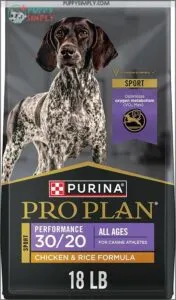
Since its debut, Purina Pro Plan’s High Calorie Dog Food has been a game-changer for active canines.
This performance formula packs a punch with 30% protein and 20% fat, designed to fuel your dog’s metabolic needs.
Real chicken leads the ingredient list, supporting muscle health and endurance.
Whether you’ve got a hunting companion or an athletic pup, this food delivers concentrated energy in every bite, making it a reliable choice for dogs needing that extra nutritional boost to maintain peak performance with concentrated energy.
Best For: Active and athletic dogs of all ages needing high-energy nutrition to support endurance and muscle maintenance.
- High protein and fat content fuels energy and supports muscle tone.
- Real chicken as the first ingredient ensures quality nutrition.
- Economical portions with long-lasting 48-pound bags.
- Expensive compared to generic dog food brands.
- Limited availability in physical stores, primarily online.
- Some reported issues with damaged packaging during delivery.
4. Grain Free Chicken Dog Food

Grain-free chicken dog food often emerges as a top choice for pet owners seeking high-calorie nutrition.
These formulas typically feature chicken as the primary protein, delivering essential nutrients without grains that might cause digestive issues.
With options like BLUE Freedom and Jinx Grain-Free Chicken, you’ll find nutrient-dense meals supporting muscle development and overall health.
These foods are crafted to provide complete nutrition, incorporating functional ingredients like probiotics and superfoods to guarantee your dog gains weight safely and effectively, with the inclusion of superfoods.
Best For: Pet owners looking for high-protein, grain-free nutrition to support their dog’s muscle development, digestion, and overall health.
- High-quality protein sources like chicken for muscle maintenance.
- Grain-free formulas suitable for dogs with sensitivities.
- Added functional ingredients like probiotics and superfoods for digestion and health.
- Price fluctuations may affect affordability.
- Some dogs may experience digestive issues with specific recipes.
- Potential formula changes may alter texture or stool quality.
5. ZIWI Peak Beef Air Dried Dog Food
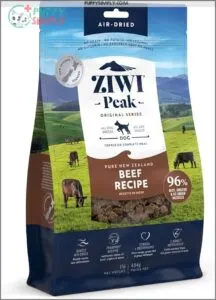
With its 96% meat, organs, and seafood composition, ZIWI Peak Beef Air-Dried Dog Food offers a nutrient-dense solution for weight gain.
This New Zealand-sourced, grain-free option delivers high-protein nutrition across all dog life stages.
Gently air-dried to preserve nutritional integrity, it includes kelp and green mussels for joint health.
Its single-source protein and absence of fillers make it ideal for dogs with sensitive stomachs or food allergies, perfect for picky eaters seeking a wholesome, ethically sourced meal.
Best For: Picky eaters, dogs with food sensitivities, and those needing high-protein, nutrient-dense meals for weight gain and overall health.
- High-protein, nutrient-rich formula with 96% meat, organs, and seafood.
- Gently air-dried process preserves nutrition and flavor.
- Ideal for dogs with sensitive stomachs or allergies.
- Expensive compared to other dog food options.
- Strong smell may be off-putting to some owners.
- Inconsistent piece sizes require careful portion measurement.
6. Earthborn Holistic Grain Free Bison Dog Food
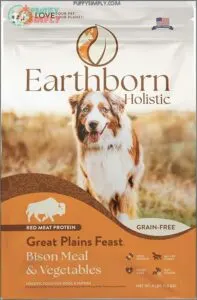
Your dog’s nutrition needs a bison-powered boost with Earthborn Holistic’s Grain Free Bison Dog Food.
This powerhouse formula delivers 360 kcal/cup, packed with high-quality bison and beef meals.
Rich in antioxidant-packed fruits and vegetables like blueberries and spinach, it supports heart and gut health.
Perfect for dogs with grain sensitivities, this food offers balanced omega fatty acids for a glossy coat, and with natural ingredients and no artificial preservatives, it’s a top-tier choice for canine weight gain and overall wellness.
Best For: Dogs with grain or gluten sensitivities needing a high-protein, nutrient-rich diet for digestive health and shiny coats.
- Grain-free and gluten-free formula with high-quality bison and beef protein.
- Packed with antioxidants, probiotics, and omega fatty acids for gut and skin health.
- Eco-friendly, resealable, and recyclable BPA-free packaging.
- Previous recalls due to aflatoxin and Salmonella contamination.
- Some dogs may refuse to eat it due to freshness or palatability issues.
- Higher price point compared to other grain-free dog foods.
7. Grain Free Beef Dog Food

When your pup needs a protein boost, Grain Free Beef Dog Food delivers.
This multi-protein formula packs a punch with 97% animal protein sources, ensuring no legumes interrupt your dog’s nutrition.
Ideal for all ages, it supports lean muscle development and sustained energy.
The natural ingredient profile promotes overall health, giving your furry friend the building blocks for a strong, vibrant life.
Your dog will appreciate the high-quality, nutrient-dense meal that keeps them feeling their best.
Best For: Active dogs of all ages needing a grain-free, high-protein diet for lean muscle development and sustained energy.
- 97% animal protein sources with no legumes.
- Supports lean muscle development and sustained energy.
- Natural ingredients promote overall health.
- May not suit dogs with sensitivities to multi-protein formulas.
- Limited information on ingredient sourcing and origin.
- Availability might vary depending on location.
8. Kinetic Performance Power 30K Dog Food

For high-performance dogs needing an energy boost, Kinetic Performance Power 30K Dog Food delivers precisely what active canines require.
With 462 calories per cup and a robust 30% protein profile, this formula supports muscle development and sustained activity.
Its grain-free composition features chicken meal and chicken by-product meal, providing clean, sustainable energy.
Perfect for sporting and working dogs, this nutrient-dense food helps your furry athlete run farther, faster, and longer while maintaining peak health and performance.
Best For: High-performance, sporting, and working dogs that require sustained energy and muscle support.
- 30% protein and 20% fat to support muscle growth and energy.
- Grain-free formula suitable for dogs with allergies.
- Helps improve coat, digestion, and overall performance.
- Mixed taste acceptance with some dogs preferring other brands.
- Larger bag sizes may not suit picky eaters.
- Premium quality may come with a higher price point.
9. ORIJEN Original Grain Free Dog Food

In the realm of premium pet nutrition, ORIJEN Original Grain Free Dog Food stands out with its impressive 85% animal protein content.
Packed with free-run chicken, turkey, and wild-caught fish, this kibble delivers a nutritional punch that’ll make your furry friend’s tail wag.
At 473 kcal per cup, it’s perfect for dogs needing a calorie boost.
The grain-free formula supports immune health, digestion, and coat quality, making it a top choice for pet parents seeking high-quality, nutrient-dense meals.
Best For: Pet parents looking for a high-protein, grain-free dog food that supports immune health, digestion, and a shiny coat.
- Made with 85% animal protein, including fresh and raw WholePrey ingredients.
- Rich in Omega-3 and Omega-6 fatty acids for skin and coat health.
- Grain-free formulation supports dogs with sensitivities or allergies.
- Premium pricing at approximately $4.00 per pound.
- Strong meat smell might not appeal to owners.
- Expiration and storage issues noted in some reviews.
10. Purina Pro Plan Sport Dog Food

Into the sphere of peak canine performance, Purina Pro Plan Sport Dog Food emerges as a powerhouse for active dogs.
With a robust 30% protein and 20% fat blend, it’s designed to fuel your furry athlete’s endurance and muscle maintenance.
Formulated for sporting breeds, this formula optimizes oxygen metabolism and supports joint health through EPA and glucosamine.
Whether you’ve got a hunting companion or an agile competitor, this food delivers targeted nutrition to keep your dog performing at its absolute best.
Best For: Highly active dogs, including sporting breeds, hunting dogs, and canine athletes requiring peak performance nutrition.
- High-protein and fat content for endurance and muscle maintenance.
- Includes glucosamine and EPA for joint health.
- Optimizes oxygen metabolism for increased athletic performance.
- Not suitable for low-energy or inactive dogs due to high-calorie content.
- Some concerns reported about bag quality and durability.
- Premium pricing criticized by some customers.
11. Natures Logic Chicken Feast Dog Food

Throughout 2025, Nature’s Logic Chicken Meal Feast emerges as a top-tier choice for dogs needing nutritional support.
A game-changing feast for furry friends: Nature’s Logic delivers pure nutrition, transforming mealtime into muscle-building magic.
Packed with 417.95 kcal per cup, this formula boasts 36% protein and includes chicken meal, millet, and chicken fat.
It’s grain-free (except for millet), gluten-free, and free from artificial additives.
The nutrient-rich recipe supports muscle development, promotes healthy digestion, and enhances coat shine, making it perfect for dogs with sensitive stomachs, and it offers a balanced approach to canine nutrition.
Best For: Dogs of all life stages needing high-protein, natural nutrition, especially those with sensitive stomachs.
- High protein content (36%) with 85% from meat sources.
- Free from artificial additives, gluten, and most grains.
- Promotes healthy digestion and coat shine with added probiotics.
- Expensive compared to other dog food options.
- Not suitable for dogs allergic to chicken or pork ingredients.
- Gradual transition required over 7-10 days to avoid digestive upset.
12. CRAVE Grain Free White Fish Salmon

Despite being a game-changer in the high-calorie dog food market, CRAVE Grain Free White Fish Salmon delivers a protein punch that’ll make your dog’s tail wag.
With 34% protein and zero chicken by-products, this grain-free formula uses white fish and salmon as primary ingredients.
It’s packed with essential vitamins and minerals, supporting lean muscle development and overall health.
Dogs love its meaty flavor, and pet owners appreciate its quality ingredients and commitment to nutrition.
Best For: Dog owners who want a grain-free, high-protein food with quality ingredients for dogs of all sizes.
- High-protein formula (34%) to support lean muscles.
- Grain-free with real white fish and salmon as primary ingredients.
- Packed with essential vitamins and minerals for overall health.
- Strong odor noted by some users.
- Price fluctuations may affect affordability.
- May require mixing with larger kibble for bigger dogs.
13. Rachael Ray Puppy Chicken and Rice

Puppy parents, meet Rachael Ray’s Puppy Chicken and Rice – a nutritional powerhouse designed to support your growing furball.
Packed with real chicken as the first ingredient, this food helps build lean muscle and promotes healthy organ development.
Its small kibble size makes it perfect for little mouths, while essential nutrients like EPA and DHA support brain and vision growth.
With clean, natural ingredients and added vitamins, it’s a reliable choice for your pup’s early nutrition journey.
Best For: Puppies in their early growth stages, especially small breeds, needing natural food with added vitamins and minerals.
- Real chicken as the #1 ingredient for lean muscle and healthy organs.
- Contains EPA and DHA for brain and vision development.
- Small kibble size, easy for puppies to chew.
- Mixed reviews; some puppies refuse to eat it.
- Contains common allergens like corn and soy.
- Not suitable for dogs with specific dietary restrictions.
14. Wellness Senior Chicken and Barley Dog Food
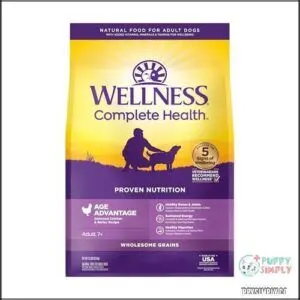
Senior dogs deserve nutrition that keeps them thriving, and Wellness Senior Chicken and Barley Dog Food delivers just that.
Packed with deboned chicken, this formula supports whole-body health through carefully balanced nutrients.
You’ll find glucosamine for joint care, omega fatty acids for a lustrous coat, and probiotics that aid digestion.
Made in the USA with non-GMO ingredients, it’s free from artificial preservatives and offers thorough nutritional support for your aging companion’s health and well-being.
Best For: Senior dogs of all sizes needing whole-body nutrition, joint support, and a balanced, natural diet.
- Contains glucosamine and omega fatty acids for joint and coat health.
- Made with non-GMO natural ingredients and free of artificial preservatives.
- Supports digestion, heart health, and immune system with probiotics and antioxidants.
- Higher price compared to some competing brands.
- Some dogs may need time to adjust to the taste or smell.
- Only available in larger 15-pound or 30-pound bag sizes, which may not suit all owners.
15. Bully Max High Protein Dog Food

If you’re looking to bulk up your furry friend, Bully Max High Protein Dog Food packs a powerful punch.
With 535 calories per cup and 30% protein, this food helps dogs build muscle and gain healthy weight across all breeds and life stages.
Made in the USA with real meat as the primary ingredient, it supports immune health and provides balanced nutrition.
Its meat-based formula guarantees your pup gets the fuel needed for peak performance and energy.
Best For: Dogs of all breeds and life stages needing high-protein, calorie-dense food for muscle growth, weight gain, and peak performance.
- Contains 535 calories per cup, with 30% protein and 20% fat for muscle development.
- Made with real meat as the primary ingredient, ensuring quality nutrition.
- Suitable for dogs 4 weeks and older, meeting AFFCO standards for balanced nutrition.
- Small kibble size may be challenging for larger breeds without soaking.
- Requires complementary exercise for optimal muscle development results.
- Limited availability of recipe options, such as beef, for variety.
Dog Weight Gain Strategies
If your dog’s struggling to pack on pounds, you’ll want to master strategic weight gain techniques that go beyond just filling the food bowl.
By understanding the right mix of high-calorie nutrition, portion control, and targeted exercise, you’ll help your pup build healthy muscle mass and regain their vibrant energy.
Improving Diet Quality for Better Digestion
Most dogs thrive on a carefully curated diet that prioritizes digestive health.
To improve your dog’s diet quality, focus on key digestibility factors:
- Choose whole, minimally processed ingredients
- Incorporate high-fiber foods from natural sources
- Select lean proteins with easy digestibility
- Add probiotics and digestive enzymes
Ultimately, a thoughtful approach to dog food ingredients can transform your pup’s gut microbiome and overall nutrition.
For underweight dogs, calorie-dense diets are often essential.
Feeding Multiple Small Meals Daily
After improving your dog’s diet quality, break their daily portions into smaller, frequent meals.
This approach boosts digestion efficiency and nutrient absorption while preventing bloat.
Consistent, smaller servings of high-calorie dog food stimulate appetite and maintain steady energy levels.
Your furry friend will appreciate the gentler feeding strategy that keeps their metabolism humming.
Supplementing With Wet Food or High-Calorie Additives
After portioning out smaller meals, you’ll want to boost your pup’s calorie intake with smart supplements.
Wet food’s high palatability and moisture enhance digestibility, making weight gain smoother.
Weight gain dog supplements like NomNomNow or homemade additives can provide calorie-rich nutrition.
Many owners find palatable options available particularly helpful.
Follow dosage guidelines carefully, focusing on nutrient-dense, easily digestible options that’ll have your furry friend feeling fuller and stronger, with easily digestible choices.
Encouraging Safe Exercise for Strength and Appetite
A thoughtful exercise regimen can be your secret weapon for helping underweight pups build strength and stimulate appetite.
Safe, gradual workouts boost muscle mass and encourage healthy eating habits.
- Start with short, low-intensity walks
- Incorporate gentle play sessions
- Monitor exercise tolerance carefully
- Use interactive toys for engagement
- Track energy levels and recovery to ensure a successful exercise regimen.
High Calorie Dog Food Benefits
When your dog’s struggling to maintain a healthy weight, high-calorie dog food can be a game-changer for their nutrition and overall well-being.
You’ll want to choose calorie-dense meals packed with protein and essential nutrients to help your furry friend regain strength and build muscle mass effectively.
Nutritional Essentials for Weight Gain
A successful weight gain journey for your furry friend starts with understanding nutritional essentials.
High-calorie dog foods packed with protein and fat can help your pup pack on healthy pounds.
Check out this quick nutrition guide:
| Nutrient | Purpose | Ideal Range |
|---|---|---|
| Protein | Muscle Building | 30-45% |
| Fat | Energy Source | 20-30% |
| Calories | Weight Gain | 400-600 kcal/cup |
AAFCO standards guarantee your pup gets balanced, nutrient-dense meals for peak health, ensuring a healthy weight gain.
Malnutrition and Its Effects on Dogs
Every underweight dog tells a story of nutritional struggle.
Malnutrition can devastate your furry friend’s health, causing weakness, poor immunity, and muscle loss.
From sunken eyes to dull coats, the symptoms are heartbreaking.
Chronic nutrient deficiencies lead to serious long-term risks: compromised growth, dental problems, and potentially shortened lifespans.
A balanced diet is essential, especially for puppy food and coat.
Your dog’s nutrition isn’t just food—it’s survival.
Health Considerations for Underweight Dogs
When malnutrition strikes your pup, understanding health considerations becomes your roadmap to recovery.
Underweight dogs need more than just extra calories—they require targeted nutrition and careful monitoring.
Your furry friend’s journey back to health involves addressing underlying conditions that may have triggered weight loss.
- Check for hidden medical issues causing weight decline
- Monitor energy levels and overall body condition
- Prioritize nutrient-dense, high-calorie dog food options
- Track progress with regular veterinary consultations
Choosing The Right High Calorie Dog Food
When malnutrition threatens your pup’s health, selecting the right high calorie dog food becomes your secret weapon.
Look for AAFCO-approved formulas with top-tier ingredient quality and digestibility factors. Consider your dog’s breed specifics and life stage when choosing calorie-rich options.
Many pet owners find success when they buy high calorie dogfood.
Nutrient-dense foods with palatability enhancers will help your furry friend pack on pounds safely and effectively, making them a great choice for pets that need to gain weight in a healthy manner.
Safe Weight Gain Tips
If you’re looking to help your underweight dog gain weight safely, you’ll need a strategic approach that goes beyond simply feeding more food.
By tracking your dog’s body condition, energy levels, and consulting with your veterinarian, you’ll guarantee a healthy and gradual weight gain process that supports your furry friend’s overall well-being.
Regular Weigh-Ins and Body Condition Scoring
Monitor your pup’s progress with regular weigh-ins and body condition scoring (BCS). Aim to check weight monthly, using a consistent scale and time of day.
Track changes visually by feeling your dog’s ribs and evaluating muscle definition. Using accurate scales is essential for monitoring progress.
Each dog’s weight gain journey is unique, so work closely with your vet to interpret body condition scoring and adjust your high-calorie feeding strategy accordingly, ensuring a proper weight gain journey.
Tracking Energy Levels and Activity
Observing your dog’s energy levels reveals vital insights into their health and high-calorie diet effectiveness.
Track their progress with these key performance metrics:
- Daily activity duration
- Intensity of exercise
- Recovery time between activities
Watch for behavioral changes that signal improved strength, like more playful interactions and sustained enthusiasm during walks, which are crucial for a successful weight gain journey, and your vigilant tracking guarantees your pup’s overall health improvement.
Assessing Coat and Skin Health
After tracking your pup’s energy, focus on their coat and skin health. A shiny, smooth coat signals good nutrition from high-calorie dog foods rich in omega 3 and 6.
Watch for allergy signs, dry patches, or dull fur that might indicate underlying conditions.
| Coat Health Indicator | Good Sign | Warning Sign |
|---|---|---|
| Coat Sheen | Glossy, smooth | Dull, rough texture |
| Skin Hydration | Supple, elastic | Dry, flaky skin |
| Parasite Presence | No visible signs | Excessive scratching |
| Overall Condition | Uniform color | Patchy, uneven coat |
The presence of a shiny, smooth coat and supple, elastic skin are key indicators of good health, while dry patches or dull fur may signal potential issues.
Observing Changes in Appetite and Eating Habits
After checking your coat’s health, keep a keen eye on your pup’s eating habits.
Watch for sudden changes in food preferences or eating speed. Picky eaters might need high calorie dog food with palatability enhancers.
Appetite loss can signal deeper issues, so don’t ignore weird shifts. Your dog’s meals tell a story – learn to read between the bites.
Consulting With a Veterinarian for Ongoing Guidance
As your dog’s appetite shifts, your veterinarian becomes your trusted navigator through weight gain challenges.
They’ll help uncover underlying conditions, recommend dietary adjustments, and provide supplement guidance.
With precise exercise plans and ongoing monitoring, they’ll track your pup’s progress, ensuring your high-calorie dog food strategy supports ideal health and helps your furry friend regain their energy.
Frequently Asked Questions (FAQs)
How Can You Tell If Your Dog Is underweight?
When your pup looks like a walking skeleton, it’s time to pay attention.
Feel their ribs—if they’re protruding sharply and lack muscle padding, you’ve got an underweight pooch that needs a nutritional intervention.
What is the best dog food to gain weight?
You’ll want Adirondack 30% Protein High-Fat Recipe, delivering 522 kcal/cup.
It’s packed with protein, supports muscle growth, and helps underweight pets gain safely.
Consult your vet to confirm it meets your furry friend’s specific nutritional needs, especially to ensure the recipe supports their health.
What is the highest calorie dog food?
Ever wondered which dog food packs the most caloric punch?
Adirondack 30% Protein High-Fat Recipe leads the pack at 522 kcal/cup, making it your top choice for high-energy pups needing serious nutritional support.
What is the highest calorie dog food for weight gain?
If you’re looking to bulk up your pup, Adirondack 30% Protein High-Fat Recipe tops the charts at 522 kcal/cup.
It’ll help your furry friend pack on pounds with high-quality protein and essential nutrients for healthy weight gain.
What food can I give my dog to gain weight?
When your furry friend needs a nutritional boost, consider high-calorie options like Adirondack’s 30% Protein Recipe, Kinetic Performance Power, or The Farmer’s Dog.
Consult your vet to choose the perfect diet for healthy, safe weight gain.
How long does it take to see weight gain?
You’ll typically see initial weight gain in 4-6 weeks with a high-calorie diet.
Consistency matters!
Monitor your dog’s progress, adjust portions carefully, and consult your vet to guarantee healthy, gradual weight improvement.
Should high-calorie food be mixed with regular food?
Just like athletes strategically fuel up before a big race, you’ll want to gradually mix high-calorie food with regular food.
Start with a 25% blend, increasing slowly to help your dog adjust and prevent digestive upset, focusing on a gradual approach.
What time of day is best for feeding?
You’ll want to feed your dog twice daily, spacing meals 8-12 hours apart.
Morning and evening work best, aligning with most dogs’ natural rhythms and helping maintain steady energy levels throughout the day.
Are homemade high-calorie foods safe for dogs?
Ever wondered if homemade dog food might be a recipe for disaster?
Proceed with caution.
Consult your vet first, verify balanced nutrition, use safe ingredients, and avoid harmful foods like onions, chocolate, and grapes that can seriously harm your pup, it is crucial to proceed with caution.
How often should a dogs diet change?
You’ll want to change your dog’s diet gradually every 6-12 months, considering age, health, and activity levels.
Consult your vet before switching to facilitate a smooth shift and meet your pup’s nutritional needs.
Conclusion
Releasing the power of high calorie dog food can transform your pup’s health journey.
You’ve learned the secrets to selecting the perfect nutrition for your furry friend.
Remember, it’s not just about calories—it’s about quality, balanced nutrition, and personalized care.
Don’t go it alone; consult your vet, track your dog’s progress, and choose foods that support their unique needs.
With the right high calorie dog food, you’ll help your pup thrive and shine.
- https://vet.osu.edu/vmc/companion/our-services/nutrition-support-service/basic-calorie-calculator
- https://www.purina.co.uk/articles/dogs/behaviour/understanding-dogs/what-dogs-need
- https://www.wellnesspetfood.com/blog/choosing-best-protein-your-dog
- https://www.nomnomnow.com/?promo=50ff&utm_source=squaredance&utm_medium=affiliate&click_id=4Vm-gbQrSIX1EmFE2j4dR_fvPVOi0V4HPMxNbEscKjhdjbW6DkZKFQ8mR2-9_TaS%2F%2F%2F&utm_campaign=394707
- https://twitter.com/K9OfMine

